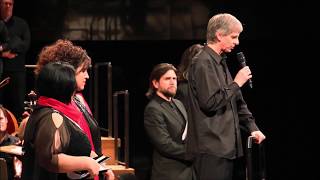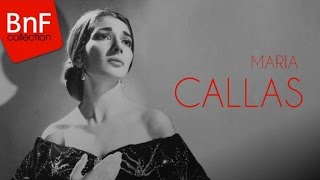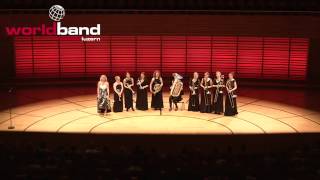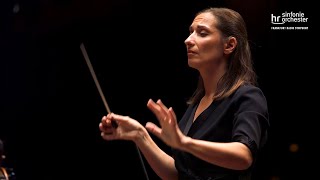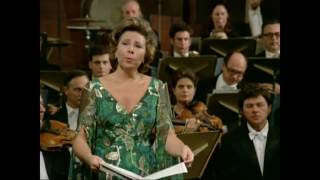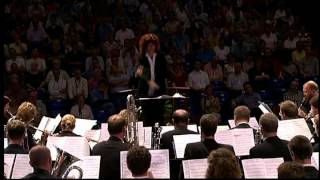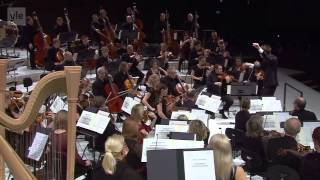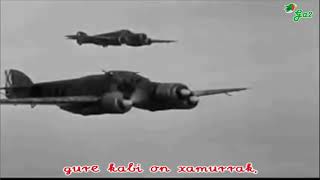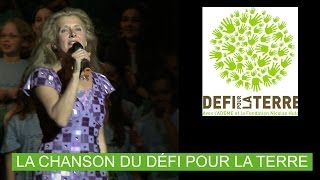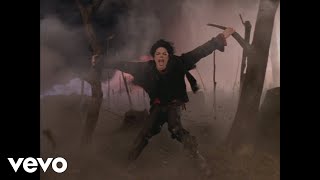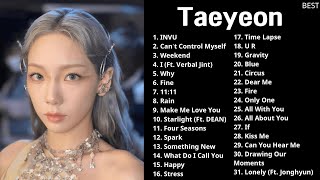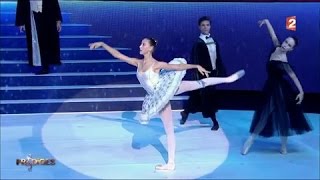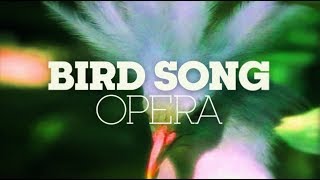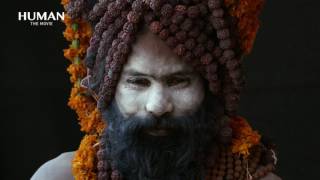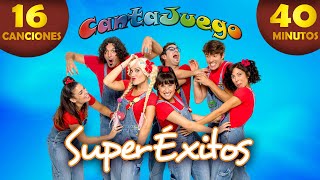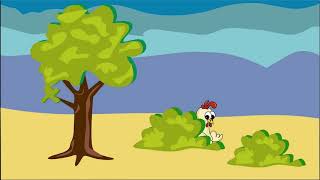April 22 Earth Day.
On April 26, 1937, fascist planes bombed the defenseless town of Gernika
Recommended music videos for initiation to classical music
Vangelis (1943) is a Greek composer of electronic and orchestral music who has written primarily for theater, ballet, film and television in a greatly majestic, almost religious style; His soundtracks include Chariots of Fire, Blade Runer and 1492: The Conquest of Paradise . He has also released several albums in which he has experienced different sound sensations with allusions to classical music, jazz, electronic music and formal minimalism . Their music is characterized by the use of synthesizers and occasionally acoustic instruments to create surround sound atmospheres, in a generally grand and solemn tone. In his honor the International Astronomical Union gave his name to an asteroid: (6354) Vangelis .
Beautiful Planet Earth offers us intimate and nostalgic music referring to a beautiful world that is leaving us.
Pablo Sorozábal (1897-1988) was born in Donostia/San Sebastián , according to his own memoirs, “into a proletarian and Basque-speaking family.” He began his violin studies at the San Sebastián Municipal Music Academy ; At the age of 17 he joined the San Sebastián Casino Orchestra and at the age of 21, the Madrid Philharmonic . With a scholarship from the Provincial Council of Gipuzkoa, he complements his studies in Leipzig and Berlin . Due to his republican ideas, after the Civil War , he was isolated as a composer, which made it difficult for him to premiere the different zarzuelas he composed in Madrid . As director of the Madrid Symphony Orchestra he ended up in bad shape in 1952 when he was prohibited from playing Shostakovich 's Leningrad Symphony , a fact that led to his resignation.
The bombing of Gernika , a city symbol of the Basque jurisdictions, was an air attack on the civilian population of this defenseless Basque population. The massacre was carried out on April 26, 1937 , by the German Condor Legion and the Italian Legionary Aviation , who were fighting on behalf of the rebel side against the Government of the Second Spanish Republic .
In memory of that massacre, Sorozábal finished rewriting the cantata Gernika in 1976, which we present today, for choir and orchestra with lyrics by Nemesio Etxaniz ; cantata which is a reworking of the Gernika funeral march written at the time for a txistus and horn ensemble. The version that we offer today is conducted by the Argentine maestro Xabier Iñaki de Arza Blanco .
Maria Callas (1923-1977) was a Greek soprano, in the opinion of many critics, the highest quality of the 20th century . With a very wide voice register and technical and expressive quality, she was capable of playing roles from mezzo to light soprano. His eventful emotional life influenced his professional work to such an extent that it caused his artistic and existential decline.
The Opera Arias that we present today is a wide collection of arias from different periods and styles with which today, in addition to enjoying their art, we can be amazed at their vocal and interpretive technique.
Aaron Copland (1900-1990) was a Russian-born American composer of classical music and film. His work is influenced by impressionism and especially by Igor Stravinsky . He stood out along with George Gershwin as one of the most important composers of the musical identity of the United States in the 20th century . In the fall of 1917 he began studies in harmony and counterpoint with Rubin Goldmark ; At his suggestion, she studied piano first with Victor Wittgenstein and from 1919 with the famous pedagogue Clarence Adler . In June 1921 he moved to France to study with Nadia Boulanger ; In 1924 he returned to the USA and the following year he was the first composer to receive the Guggenheim fellowship , which he renewed in 1926.
Rodeo is a ballet referring to the American West , composed by Aaron Copland and choreographed by Agnes de Mille , which premiered in 1942 and consists of five sections. The original ballet was choreographed for the Ballet Russe de Monte-Carlo , a dance company that moved to the USA during World War II . Among many reviews stood out De Mille 's highly evocative choreography, described as having "cinematic sensibility" and recognized for its realism.
Today we offer the musical fragment of this ballet, Hoe-Down , prepared for a female metal ensemble led by Tine Thing Helseth .
Recommended classical music videos
Pastoral Symphony (Symphony No. 6). As a good lover of nature, Beethoven liked to get away from the big city to relax in rural towns and walk through the fields. After having titled his sixth symphony “ Memories of a Country Life ,” he said that he intended “more expression of feelings than painting of sounds.” The symphony consists of five movements that are subtitled as follows: I (0'7”) AWAKENING TO JOYFUL FEELINGS WHEN FINDING YOURSELF IN THE FIELD.-. II (11´52´´) SCENE NEXT TO THE STREAM .-. III (24´11´´) LIVING MEETING OF PEASANTS .-. IV (29´12´´) LIGHTNING. STORM .-. V (32´47´´) ANTHEM OF THE SHEPHERDS. JOY AND FEELINGS OF GRATEFUL AFTER THE STORM.
The catalog of Beethoven's works . There are 138 musical works composed by Beethoven , arranged by numbers known as opus (“work” in Latin) or its abbreviation op. , assigned by the composer's publishers while he was alive. On the sidelines, there are another 205 works that do not have an opus number and that were published after the composer's death. These works were assigned WoO numbers (Werke ohne Opuszahl, "works without opus number"). This catalog was first produced by Georg Kinsky and Hans Halm (Das Werk Beethovens) in 1955.
In the video we present today, the French teacher Ariane Matiakh , conducting the Frankfurt Radio Symphony, offers us Beethoven's Sixth Symphony .
Gustav Mahler (1860-1911) was an Austrian composer and conductor born in Kaliště , currently Czechia , considered one of the most eminent composers of post-romanticism. His creative work focused on the symphony , the lied (lyrical song) and the conjunction of both concepts; To this we must add the diversity of elements with which he worked (popular melodies, military melodies, fanfares of various types...), the manifest dissonances to which the public was not accustomed and the long duration of his symphonies; If we add to this that he faced a certain anti-Semitic press due to his Jewish origins, it is not surprising that his compositions did not have the success he deserved in his lifetime.
Das Lied von der Erde (The Song of the Earth) is a song cycle (lied) in symphony form, a large-scale work for two vocal soloists and orchestra written by Gustav Mahler and structured in six movements: I (0´ 00´´) DAS TRINKLIED VON JAMMER DER ERDE (The Bacchic Song of Earthly Misery) .-. II (8:35) DER EINSAME IM HERBST (The Loner in Autumn) .-. III (19'05'') VON DER JUGEND (Of Youth) .-. IV (22:15) VON DER SCHÖNHEIT (Of Beauty) .-. V (30´04´´) DER TRUNKENE IM FRÜHLING (The Drunkard in Spring) .-. VI (34´32´´) DER ABSCHIED (The Farewell).
Today we offer it in a version by mezzo-soprano Christa Ludwig and tenor René Kollo accompanied by the Israel Philharmonic conducted by maestro Leonard Bernstein .
Atrocious genocide . At this moment, we denounce in the most energetic way the atrocious genocide that the State of Israel is committing against the Palestinian People and we are committed to a peaceful understanding, while at the same time we dream of a fraternal collaboration between both peoples.
Bert Appermont (Bilzen, December 27, 1973) is a Belgian music educator, conductor, composer and arranger. He studied counterpoint, fugue, orchestra and conducting respectively at the Lemmens Institute in Leuven . In 1998 he completed his studies there with a double master's degree in music education and HaFaBra conducting (HArmonie, FAnfare and BRAss band music). He continued his studies at Bournemouth Media School in England . There he obtained a Master's Degree in Musical Design for Film and Television , which gave him extensive knowledge of composition techniques for musicals, film and television. As a composer, in addition to two musicals, he has composed about one hundred works for choir, chamber music ensemble, wind orchestra and symphony orchestra.
Symphony No. 1 Gilgamesh. Written for Brass Band , the Symphony is composed of 4 movements: I (4´13´´) The first movement, GILGAMESH AND ENKIDU, presents the two half-gods Gilgamesh and Enkidus.- . II (9´14´´) In the second movement, BATTLE OF THE TITANS, the two characters fight a heroic battle against each other and discover that they have the same strength.-. III (16'14'') In the third movement, ADVENTURES IN THE FOREST, they become friends and undertake different adventures in the forest, where they fight against all kinds of dangerous creatures. IV (21´17´´) In the last movement, JOURNEY TO UTNAPISHIM, Enkidu tries to find an answer to mortality when his friend Gilgamesh dies.
Today's interpretation is offered to us by the Landesblasorchester conducted by the Swiss maestro Isabelle Ruf-Weber
Krzysztof Penderecki (1933-2020) was a Polish classical composer and conductor, known for his compositional style, specifically recognizable in his atonal works, some of which have been used for famous films. He studied music at the Kraków Music Academy with Artur Malawski and Stanislaw Wiechowicz . After graduating in 1958, he took a teaching position at the Academy . Penderecki 's early works show the influence of Igor Stravinsky, Anton Webern and Pierre Boulez . His international recognition began in 1959 at the Warsaw Autumn Festival with the premiere of the piece Lament for the Victims of Hiroshima .
Threnody for the Victims of Hiroshima is a musical composition for 52 bowed string instruments, composed in 1960 by Krzysztof Penderecki. The unorthodoxy of the work, which mostly uses graphic notation, directs the musicians to play at various times at vague points in their register or to concentrate on certain textural effects. Penderecki attempted to increase the effects of traditional chromaticism by using " hypertonality " (composing in quarter tones); and integral serialism . The piece creates a total musical texture that is more important than the individual notes, in their entirety; On the other hand, the treno constitutes one of the most extensive elaborations on clusters.
Today we offer it in the version of the Finnish Radio Symphony Orchestra conducted by the Polish maestro Krzysztof Urbański .
Recommended music videos for all tastes
Bertsolaritza (or Bertsolaritza, which is sometimes written as versolarismo in texts in Spanish) is the art of singing in verse in an improvised way to converse or deliver a speech, rhyming and with an established meter. The word bertso, in Basque, is equivalent to what in Spanish is a stanza written according to a specific meter. Bertsolarismo is a very popular cultural manifestation with a great tradition throughout the Basque Country ; It is long before any usual written manifestation of Basque, since it arises from spontaneous oral literature. The written history of improvisational bertsolaritza can be dated to the year 1800; It is the time of Beñat Mardo and Pernando Amezketarra . These untutored bertsolaris challenged each other by singing.
Today the bertsolari Joseba Tapia offers us a series of bertsos referring to the massacre carried out by fascist planes against the defenseless population of Gernika .
Dominique Dimey , born in 1957 in Issoudun , is a French singer-songwriter, who mainly dedicates her career and repertoire to children. The quality of his songs and his commitment to the rights of children around the world and the protection of the environment, give him a unique place in the panorama of French song . Her concerts take her on tour around the world to carry out actions dedicated to information and education together with large NGOs .
The song Le Défi pour la Terre , written by Dominique Dimey to launch the Earth challenge, is a song recorded on the album “ Hands of my planet! ” with ambassadors such as: Enzo Enzo, Emmanuel Petit, Claire Keim, Maud Fontenoy … The song referred to is part of the live concert recorded at the Victoria Hall with the children of the Geneva schools.
Michael Jackson (1958-2009) was an American singer, songwriter, producer and dancer, nicknamed the "King of Pop", his contributions and recognition in the history of music and dance for more than four decades, as well as his publicized personal life, made him an international figure in popular culture. His music includes a wide range of genres such as pop, rhythm and blues (soul and funk), rock, disco and dance , and he is recognized as the "most successful musical artist of all time" by Guinness World Records . He began his artistic career, along with some of his brothers, in the musical group The Jackson 5 with ten albums published and beginning his career in 1971 as a soloist, although he continued to belong to the group.
Earth Song is a song by Michael Jackson for his ninth studio album, HIStory: Past, Present and Future, Book I released on November 7, 1995. " Earth Song " is a ballad that incorporates elements of blues, gospel and opera and which was the first song in which Jackson spoke openly about the environment and animal welfare. It was accompanied by a lavish music video filmed in four geographic regions, focusing on the destruction and rebirth of the Earth , and which received a Grammy nomination in 1997 and reached number one at Christmas 1995 in the UK . It also topped the charts in Germany, Iceland, Scotland, Spain, Sweden and Switzerland , while peaking at number two in France, Ireland and the Netherlands .
Taeyeon (Jeonju, March 9, 1989) is a South Korean singer, she is a legendary K-pop icon, who has been recognized as one of the most influential artists in South Korea . She rose to fame in 2007, after debuting as the leader and lead vocalist of the girl group Girls' Generation . In 2015, he debuted as a solo artist with his first mini-album I , which reached first place on the US Billboard World Albums chart and included a single of the same name, which ranked first on the Gaon Singles Chart in Korea . from the south . Having sold over 1.3 million physical albums and over 20 million digital singles, she is one of South Korea 's best-selling solo artists. As of 2022, she was the best-selling solo artist in Gaon Album Chart history.
Recommended peculiar videos
Wolfgang Amadeus Mozart (1756-1791) is considered one of the three giants of musical composition along with Bach and Beethoven . Child prodigy born in Salzburg (Austria), at the age of six he mastered the keyboard and violin and began to compose. His father, Leopold, exhibited him on exhausting tours of different European courts. Prolific composer (more than 600 works written from the time he was five years old until his death) he cultivated all types of musical genres: piano works, chamber music, symphonies, concert works, choral works, operas... each and every one of them, masterpieces of its gender. His operas The Magic Flute, Don Giovanni, Cosí fan Tutte, and The Marriage of Figaro are among the 10 most performed operas in the world. He died in Vienna at the age of 35.
Marilou is one of the nine finalists competing for the title of Prodiges of the Year 2016. In today's case, she offers us the choreography of the final part of the Dies Irae of Mozart 's Requiem , which is the Lacrimosa accompanied by the National Orchestra of Pays de la Loire .
ShakeUp Music recomposed the Magic Flute duet "Papageno/Papagena" into a colorful Mozart bird aria. Listen to an audiovisual Twitter storm conducted by our feathered companions. (Extracted from the comment at the bottom of this video)
"...The idea with Human was to create songs that reflected the same emotion generated by the interviews. I wanted things to open up, for the heart to open, for the sadness to be unbridled. Human has been one of those rare moments in my life as a film composer during which I was able to express all these different cultures at the same time: whether working on minimalist songs or meeting these singers and musicians who come from all over the world. Which note did I produce first? I had more of a overall vision, an atmosphere that would merge with the film and bring people together; this was my starting point. The part I created for the Mongolia sequence (21'25'') could be the best summary of the atmosphere that “I wanted him to have the film…” ( Armand Amard , composer of Human Music) .
I (0´27´´) Faces .-. II (4´33´´) Flamencos .-. III (6´18´´) Tenuous .-. IV (8'00'') Dam in China.-. V (10´46´´) Sorry .-. VI (12´20´´) Castells .-. VII (15'14'') Nepal .-. VIII (17´33´´) Rice fields .-. IX (21´25´´) Mongolia .-. X (25´10´´) Human Storm .-. XI (29'00'') Shakuhachi .-. X (33´) Plowing .-. XI (36') Effort .-. XII (39´26´´) Immigration .-. XIII (45´35´´) Haiti .-. XIV (48´10´´) Pepe Mujica .-. XV (51´40´´) The Hidden Church .-. XVI (55´10´´) Childhood .-. XVII (59´48´´) Swimming in China .-. XVIII (1h 04´46´´) CODA Human I
Belly dance , Egyptian dance , or correctly called oriental dance is the scenic evolution of various ancient traditional dances from the Middle East , along with others from North Africa and Greece . The raqs baladi is a very elementary dance, practically without movements and with movements mainly of the pelvis. This dance evolves into Oriental dance or raqs sharqi , which includes movements from Egyptian folklore, classical and contemporary Western dance, with great movements, turns and movements of all parts of the body, but especially the pelvis. In Turkey , belly dancing is known as gobek dans or rakasse (Turkish rhythm). In English-speaking countries it has been translated as belly dance , in Spanish belly dance and in French danse du ventre .
Jennifer Cormier Daly ("Jeni") has been dedicated to studying and performing the art of belly dance since 2003. She began her training at a young age at the Donna Miceli Dance Center in Massachusetts , where she built her foundation in ballet and jazz . After graduating from Emerson College , she moved to Los Angeles , where her passion for the art along with her Lebanese heritage led her to the world of Middle Eastern dance. In Los Angeles she performed regularly in the best nightclubs, restaurants and exclusive private events, although she recently moved to the New England area.
In this video, he offers us an improvised variant of Belly Dance from Florida Tribal Dance .
Recommended music videos for children
Various Wikipedia articles have been used to write these texts.
The texts of Videomusicalis are written in Basque, Spanish and English.






